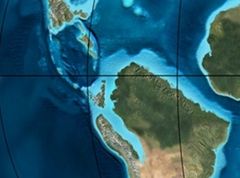| Loma Gorda Formation | |
|---|---|
| Stratigraphic range: Turonian-Coniacian ~ | |
| Type | Geological formation |
| Unit of | Güagüaquí Group |
| Underlies | Oliní Group |
| Overlies | Hondita Formation |
| Thickness | up to 167 m (548 ft) |
| Lithology | |
| Primary | Siltstone, shale |
| Other | Calcareous concretions |
| Location | |
| Coordinates | 4°15′37.5″N 74°43′28.7″W / 4.260417°N 74.724639°W |
| Region | Cundinamarca, Huila & Tolima |
| Country | |
| Extent | Upper Magdalena Valley, Central & Eastern Ranges, Andes |
| Type section | |
| Named for | Loma Gorda ("Fat Hill") |
| Named by | De Porta |
| Location | Ricaurte, Cundinamarca |
| Year defined | 1966 |
| Coordinates | 4°15′37.5″N 74°43′28.7″W / 4.260417°N 74.724639°W |
| Region | Cundinamarca, Huila, Tolima |
| Country | |
 Paleogeography of Northern South America 90 Ma, by Ron Blakey | |
The Loma Gorda Formation (Spanish: Formación Loma Gorda, Kl, Kslg) is a fossiliferous geological formation of the Upper Magdalena Valley (VSM) and surrounding Central and Eastern Ranges of the Colombian Andes, extending from Cundinamarca in the north to Huila and easternmost Tolima in the south. The uppermost unit of the Güagüaquí Group, a sequence of laminated siltstones and shales, dates to the Late Cretaceous period; Turonian to Coniacian epochs, and has a maximum thickness of 167 metres (548 ft).